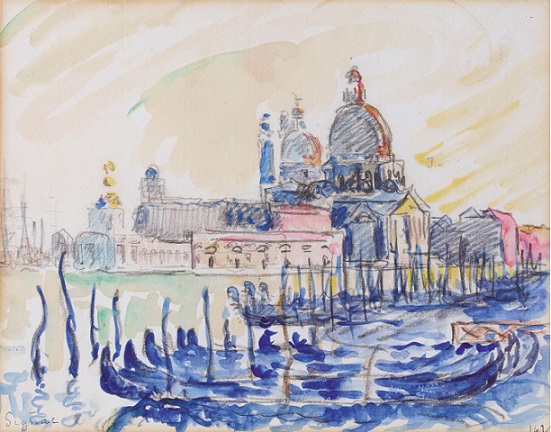Paul Signac, 1863 - 1935
VENISE, LA SALUTE, c. 1904
Watercolour, gouache and pencil on paper
20 by 25.5cm., 8 by 10in.
Private collection
Santa Maria della Salute (English: Saint Mary of
Health), commonly known simply as the Salute, is a Roman Catholic
church and minor basilica located at Punta della Dogana in the Dorsoduro
sestiere of the city of Venice, Italy.
It stands
on the narrow finger of Punta della Dogana, between the Grand Canal and the
Giudecca Canal, at the Bacino di San Marco, making the church visible when
entering the Piazza San Marco from the water. The Salute is part of the parish
of the Gesuati and is the most recent of the so-called plague churches.
In 1630,
Venice experienced an unusually devastating outbreak of the plague. As a votive
offering for the city's deliverance from the pestilence, the Republic of Venice
vowed to build and dedicate a church to Our Lady of Health (or of Deliverance,
Italian: Salute). The church was designed in the then fashionable baroque style
by Baldassare Longhena. Construction began in 1631. Most of the objects of art
housed in the church bear references to the Black Death.
The dome of the Salute was an important addition to the
Venice skyline and soon became emblematic of the city, inspiring artists like
Canaletto, J. M. W. Turner, John Singer Sargent, and the Venetian artist
Francesco Guardi. More
on Santa Maria della Salute
Paul Signac, (born Nov. 11, 1863,
Paris, France—died Aug. 15, 1935, Paris) French painter who, with
Georges Seurat, developed the technique called pointillism.
When he was 18, Signac gave up the study of architecture for
painting and, through Armand Guillaumin, became a convert to the colouristic
principles of Impressionism. In 1884 Signac helped found the Salon des
Indépendants. There he met Seurat, whom he initiated into the broken-colour
technique of Impressionism. The two went on to develop the method they called
pointillism, which became the basis of Neo-Impressionism. They continued to
apply pigment in minute dabs of pure colour, as had the Impressionists, but
they adopted an exact, almost scientific system of applying the dots, instead
of the somewhat intuitive application of the earlier masters. In watercolours
Signac used the principle in a much freer manner. After 1886 he took part
regularly in the annual Salon des Indépendants, to which he sent landscapes,
seascapes, and decorative panels. Being a sailor, Signac traveled widely along
the European coast, painting the landscapes he encountered. In his later years
he painted scenes of Paris, Viviers, and other French cities.
Signac produced much critical writing and was the author of
From Eugène Delacroix to Neo-Impressionism (1899) and Jongkind (1927). The
former book is an exposition of pointillism, while the latter is an insightful
treatise on watercolour painting. More on Paul Signac
Please visit my other blogs: Art Collector, Mythology, Marine Art, Portrait of a Lady, The Orientalist, Art of the Nude and The Canals of Venice, Middle East Artists, 365 Saints, 365 Days, and Biblical Icons, also visit my Boards on Pinterest
Images are copyright of their respective owners, assignees or others.
Some Images may be subject to copyright
I don't own any of these images - credit is always given when due unless
it is unknown to me. if I post your images without your permission, please tell
me.
I do not sell art, art prints, framed posters or reproductions. Ads are
shown only to compensate the hosting expenses.
If you enjoyed this post, please share with friends and family.
Thank you for visiting my blog and also for liking its posts and pages.
Please note that the content of this post primarily consists of articles
available from Wikipedia or other free sources online.




No comments:
Post a Comment